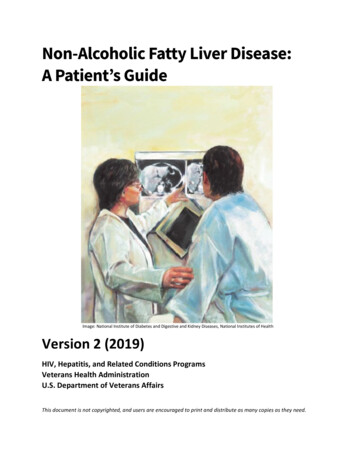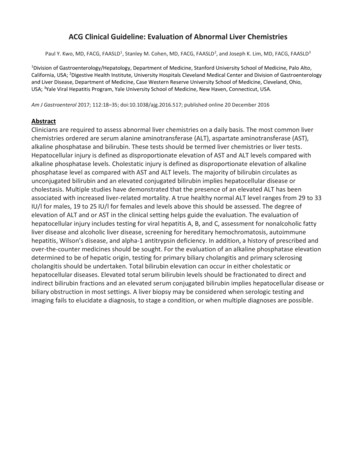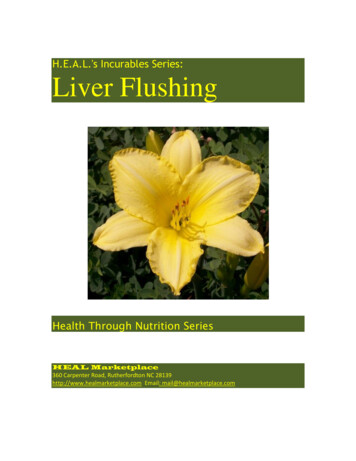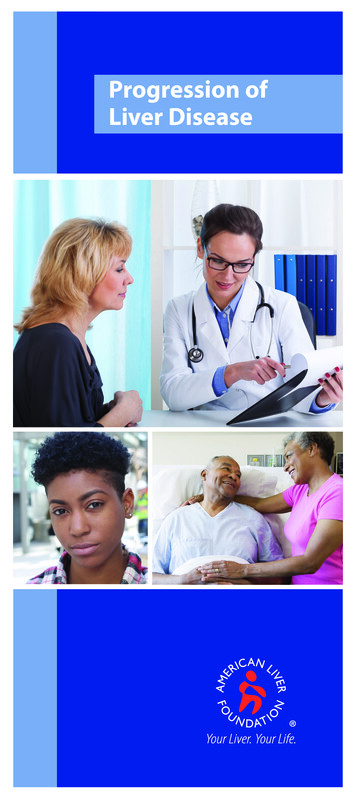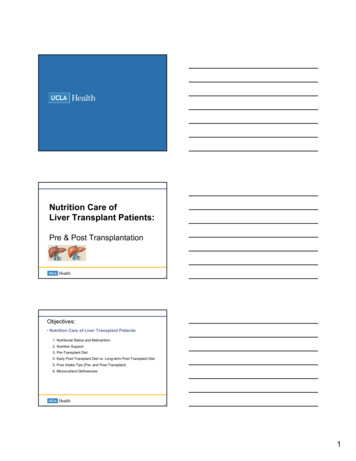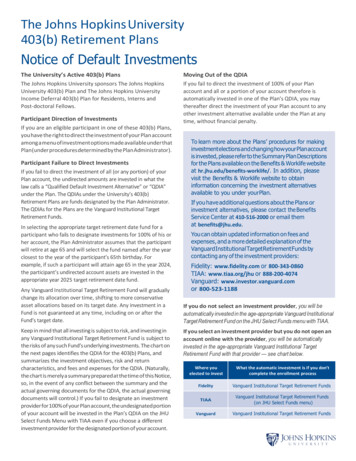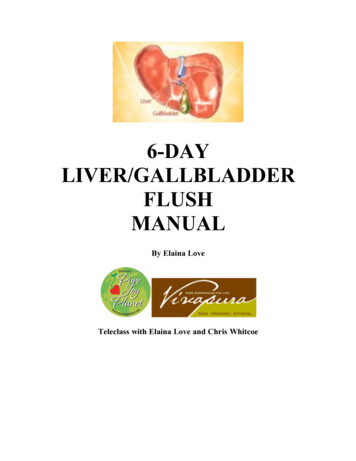
Transcription
Alcoholic Liver Disease:IntroductionAlcohol is used by approximately 75% of the population of the United States, with a 7% incidence of alcoholism. In addition, alcoholaccounts for approximately 100,000 deaths in the U.S. each year, with nearly 20% of those deaths attributable to cirrhosis.Alcohol dependence and/or abuse rates are higher for men than women and for non-blacks than blacks (though blacks have ahigher rate of cirrhosis). Alcohol abuse presents serious public health and social problems, all of which are preventable.Figure 1. .Location of liver in body.What is Alcoholic Liver Disease?As the name implies, alcoholic liver disease is liver injury attributed to alcohol abuse. The majority of Americans manage to drink alcohol without seriousconsequences. Research suggests, however, that liver disease may begin to develop after a "threshold" dose of alcohol has been consumed—generally assumed tobe four drinks a day (four 12 ounces beers, four glasses of wine, or four ounces of hard liquor) for men, and one half that quantity for women. Nearly everyone whoconsumes this amount or more will have some evidence of liver injury, although less than 50% will develop serious liver disease.SymptomsThe range of clinical features of alcoholic liver disease varies, from asymptomatic to end-stage liver disease with portal hypertension, jaundice and encephalopathy(Figure 6). Patients may present with nonspecific digestive tract symptoms such as nausea, dry retching, diarrhea, anorexia, and abdominal pain—but often they waituntil severe liver decompensation forms before consulting a physician. Patients may also seek medical attention as a result of the consequences of alcoholism, whichmay include accidents, violent behavior, depression, tremors, poor work performance, or social disruptions.Fatty liver is usually asymptomatic. On evaluation hepatomegaly is present in 70% of patients and there may be mild abnormalities in transaminases.Patients with alcoholic hepatitis may also be asymptomatic. Hospitalized patients usually have jaundice and hepatomegaly and may exhibit ascites, encephalopathy,and fever depending on the severity of their disease.Figure 2. Signs and symptoms of alcohol-related liver disease.Most patients with alcohol-induced cirrhosis have hepatomegaly and/or splenomegaly. Clinical presentation is similar to other forms of end-stage liver disease butmay be accompanied by concurrent alcoholic hepatitis. Spider angiomata are frequently found in this patient population, along with palmar erythema, enlargement ofparotid and lacrimal glands, testicular atrophy, ascites, venous collaterals, jaundice and encephalopathy.HistologyAlcoholic liver disease is defined by three stages of liver damage following chronic heavy alcohol consumption: fatty liver, alcoholic hepatitis, and fibrosis/cirrhosis(Figure 5). However, the assumption that alcoholic liver disease always progresses linearly from alcoholic fatty liver, to alcoholic hepatitis and ultimately to cirrhosis isnot correct. Stages of histologically detectable liver damage often overlap—and some cases of alcoholic liver disease never progress, regardless of the patient’scontinued ethanol abuse.
Fatty liver, or steatosis, is an abnormal accumulation of fat in the parenchymal cells of the liver and can occur within hours of significant alcohol intake. In the majorityof patients (90%) it is associated with palpable liver enlargement. Fat deposits accumulate predominantly in the central and mid-zonal areas of the liver (zones 3 and2) and may be macrovesicular (large droplets) or microvesicular (small droplets). Other conditions, such as nonalcoholic fatty liver disease, drug toxicity and fatty liverof pregnancy may cause steatosis that is indistinguishable from alcoholic fatty liver. Fatty liver is a completely reversible lesion, assuming the patient abstains fromalcohol.One-third of chronic heavy alcohol users develop alcoholic hepatitis and most will have no symptoms. The prognosis is variable and depends on the severity ofdisease. Classic signs of alcoholic hepatitis include fatty changes, necrosis of liver cells, Mallory bodies and perivenular inflammatory infiltrates (especiallyneutrophils). Mallory bodies, eosinophilic collections of intermediate filaments found in the cytoplasm, are detected in most patients with alcoholic hepatitis but alsooccur with other liver diseases.Fibrosis (or scar formation) first begins in the pericentral zone and then progresses if injury continues. If fibrosis is found on biopsy, it predicts a progression tocirrhosis or end-stage liver disease. Alcoholic cirrhosis is of the micronodular type. The normal lobular architecture is obscured and central veins are difficult to locate.The amount of fat is variable and alcoholic hepatitis may or may not be present. Continuing necrosis and fibrosis results in the progression from a micro- to amacronodular pattern. This progression is accompanied by a reduction in steatosis in end-stage liver disease. Cirrhosis is not reversible. Copyright 2001-2013 All Rights Reserved.600 North Wolfe Street, Baltimore, Maryland 21287
Alcoholic Liver Disease:AnatomyThe liver is the largest organ in the abdominal cavity and the most complex (Figure 7). It consists of a myriad of individual microscopic functional units called lobules.The liver performs a variety of functions including the removal of endogenous and exogenous materials from the blood, complex metabolic processes including bileproduction, carbohydrate homeostasis, lipid metabolism, urea formation, and immune functions.The liver is located in the right upper quadrant, between the fifth intercostal space in the midclavicular line down and the right costal margin. It weighs approximately1800 grams in men and 1400 grams in women. The surfaces of the liver are smooth and convex in the superior, anterior and right lateral regions. Indentations fromthe colon, right kidney, duodenum and stomach are apparent on the posterior surface.Figure 4. Anatomy of the liver; A, gross view; B, histological (microscopic) view.The line between the vena cava and gallbladder divides the liver into right and left lobes. Each lobe has an independent vascular and duct supply. The lobes aredivided into eight segments each containing a pedicle of portal vessels, ducts, and hepatic veins.The portal venous system extends from the intestinal capillaries to the hepatic sinusoids (Figure 8). This system carries blood from the abdominal gastrointestinaltract, the pancreas, the gallbladder and the spleen back to the heart (coursing through the liver). The largest vessel in this system is the portal vein, which is formedby the union of the splenic vein and superior mesenteric veins. The left gastric and right gastric veins and the posterior superior pancreaticoduodenal vein draindirectly into the portal vein. The portal vein runs posterior to the pancreas and its extrahepatic length is anywhere from 5 to 9 centimeters. At the porta hepatis, itdivides into the right and left portal veins within the liver, and the cystic vein typically drains into the right hepatic branch.Figure 5. Anatomy of the portal venous system.The portal vein supplies 70% of the blood flow to the normal liver, but only 40% of the liver oxygen supply. The remainder of the blood comes from the hepatic artery,and blood from both vessels mixes in the sinusoids.The liver receives a tremendous volume of blood, on the order of 1.5 liters per minute. This dual blood supply—from the portal vein and hepatic artery—allows theliver to be relatively resistant to hypoxemia. Unlike the systemic vasculature, the hepatic vascular system is less influenced by vasodilation and vasoconstriction. Thisis due to the fact that sinusoidal pressures remain relatively constant in spite of changes in blood flow. A classic example is hepatic vein occlusion resulting in highsinusoidal pressure and extracellular extravasation of fluid. To maintain a constant inflow of blood, hepatic artery blood flow is inversely related to portal vein flow. Thisappears to be hormonally mediated rather than neurally mediated, since it persists even in the transplanted liver. Copyright 2001-2013 All Rights Reserved.600 North Wolfe Street, Baltimore, Maryland 21287
Alcoholic Liver Disease:CausesIntroductionAlthough alcohol ingestion is required to develop alcoholic liver disease, not everyone who consumes the "threshold dose" of alcohol will develop the disease.Amazingly, nearly 50% of individuals who ingest large amounts of ethanol are spared serious injury. In addition to the amount and duration of alcohol use, severalother factors have been linked to an increased risk for the development of liver disease. These include genetics, gender, viral liver disease, nutrition, and exposure toother hepatotoxins.GeneticsPolymorphisms exist in the enzymes ADH, CYP2E1, and ALDH. Differences in ADH and ALDH certainly contribute to the negative association with ethanoldependence in some Asian populations. HLA phenotypes, a genetic predisposition toward alcoholism and female gender may also contribute to overall risk.Viral Liver DiseaseConcurrent viral hepatitis increases the incidence of liver injury in alcoholics. Studies have shown that alcoholics co-infected with hepatitis C virus (HCV), (but notnecessarily hepatitis B virus), develop liver injury at a younger age and with a lower cumulative dose of alcohol than those not infected with HCV. These patients alsohave a much higher chance of developing cirrhosis and hepatocellular cancer compared to alcoholics without hepatitis C (Figure 9).Figure 6. B, Hepatitis B virion; C, Hepatitic C virion.NutritionInitial hypotheses suggested that alcoholic liver disease was a result of alcohol intake in the face of poor nutrition. Today, however, it is understood that whilemalnutrition may worsen the severity of disease and obesity may increase the risk of developing disease, alcoholic liver disease does indeed occur in well-nourishedindividuals. Nutrition probably plays a role in hepatotoxicity. Current research suggests that patients with diets deficient in essential nutrients are more susceptible tothe development of liver damage. Alcohol ingestion promotes the absorption of iron from the intestine, increasing hepatic iron stores. Iron acts as an electron donor,accelerating the generation of unstable free oxygen radicals. In addition to contributing to membrane injury, this may also exacerbate inflammatory response.Hepatotoxin ExposureIn general, two insults are worse than one. Just as viral hepatitis increases the risk to develop alcohol related liver injury, other hepatotoxins may act synergistically oradditively with alcohol. This is especially true with acetaminophen and vitamin A overdose.PathogenesisSeveral factors have been proposed to explain the pathogenesis of alcoholic liver injury. These include:Variations in alcohol metabolismCentrilobular hypoxiaInflammatory cell infiltration and activationAntigenic adduct formationVariations in alcohol metabolismAlcohol must be metabolized in order for liver injury to occur, and there are several pathways that contribute to its metabolism.The major pathway occurs in the liver and begins by breaking ethanol into acetaldehyde via the enzyme alcohol dehydrogenase (ADH) (Figure 2). This in turn isbroken down to acetate by the enzyme acetaldehyde dehydrogenase (ALDH). There is considerable genetic variability in both of these enzymes, which may accountfor differences in blood alcohol levels but does not predict susceptibility to liver disease. Asians typically have efficient ADH but deficient ALDH. This allows
acetaldehyde to build up causing flushing, tachycardia, hypotension and, usually, an aversion to alcohol.Figure 7. Products of ethanol metabolism in the liver.When alcohol concentration overwhelms the ADH pathway, it is typically oxidized by the microsomal ethanol oxidizing system (MEOS) and catalase. Generally, thesepathways are more likely to generate injurious byproducts. Cytochrome P-450 2E1 (CYP2E1), a critical enzyme in MEOS, is up-regulated with chronic alcoholingestion. Polymorphisms of CYP2E1 also exist and may correlate with differences in susceptibility to hepatocellular (liver) damage. In addition, CYP2E1 isresponsible for metabolizing other drugs such as acetaminophen. This may help explain an alcoholic's increased risk to Tylenol -induced liver injury even atrecommended doses.Centrilobular hypoxiaLiver injury is most prominent in the zonal region surrounding the central vein. This area is furthest from oxygenated blood and has the highest concentration ofCYP2E1, suggesting that oxygen debt contributes to injury (Figure 12).Figure 8. High concentration of CYP2E1 surrounding the central vein in the liver.Inflammatory cell infiltration and activationProinflammatory cytokines and inflammatory cells are often found in the blood and liver of patients with alcoholic hepatitis. Although several cytokines are present inpatients with alcohol related liver injury, studies have concentrated on interleukin-8 (IL-8) and tumor necrosis factor-alpha (TNF-alpha) as both correlate inversely withprognosis. These mediators may contribute to injury by promoting leukocyte adherence and activation. Kupffer cells (macrophages in the liver) may also be animportant source of injury as they produce inflammatory and fibrogenic cytokines after being activated by alcohol. Chronic alcohol ingestion ultimately increasesintestinal permeability, allowing endotoxins into the portal blood (Figure 4). This may exaggerate the release of cytokines and oxygen radicals from alcohol-primedKupffer cells.Figure 9. Initiation of inflammation in the liver.Antigenic adduct formation
Ethanol is metabolized to acetaldehyde and can also result in the formation of hydroxyethyl radicals. These radicals bind to hepatocellular proteins altering theproteins (forming adducts that are antigenic) and provoking an immune response. The contribution of autoimmunity in alcoholic liver injury is not clear. Antibodies tothese adducts are found in serum from alcoholic patients. Animal studies have shown that guinea pigs immunized with acetaldehyde-protein adducts develop hepaticinjury and fibrosis after ethanol ingestion. Other studies suggest that these adducts are not always located in areas that are accessible to the production of an immuneresponse (e.g., retained within the hepatocyte). Copyright 2001-2013 All Rights Reserved.600 North Wolfe Street, Baltimore, Maryland 21287
Alcoholic Liver Disease:DiagnosisHistoryA history of habitual ethanol consumption is key in suggesting alcohol as the cause of liver disease. The type of beverage most often consumed, be it beer, wine, ordistilled spirits does not influence the likelihood of ethanol-induced hepatotoxicity. Alcohol intake at two or more drinks a day should raise suspicion as patients mayunderestimate their intake or have concomitant hepatic insults.Biochemical TestsBlood tests are useful in the evaluation of disorders of the liver and biliary system. There are several laboratory abnormalities characteristic of alcoholic liver disease.However, these abnormalities do not necessarily correlate with disease severity.AminotransferasesAminotransferase abnormalities are common in alcoholic liver disease. A disproportionate increase of serum aspartate aminotransferase, AST (SGOT) compared toalanine aminotransferase, ALT (SGPT) is highly suggestive of alcoholic liver injury— especially if the ratio of AST:ALT is greater than 2.0. Aminotransferase levels aregenerally lower than 300 IU/L, and other etiologies for liver disease should be considered if the enzymes concentrations are higher than this.Gamma glutamyl transpeptidaseGamma glutamyl transpeptidase (GGTP) is a membrane-associated enzyme involved in the uptake of amino acids. Increased serum activity of GGTP is often foundin chronic alcohol users—in fact, over 70% of alcoholic individuals have elevated GGTP activity. Unfortunately, several other medications also increase GGTP andtherefore this value must only be considered in combination with other laboratory and clinical information.Hematologic and electrolyte abnormalitiesMean corpuscular volume (MCV), serum uric acid levels and serum electrolytes are all affected by chronic alcohol consumption. In addition, although symptoms maybe nonspecific, increased serum uric acid, hypokalemia, hypomagnesemia and acidosis are indicators that alcohol may play a significant role in liver disease. Alcoholrelated bone marrow toxicity and/or splenic sequestration might contribute to macrocytosis (increased MCV) and thrombocytopenia. Leukocytosis is frequent inindividuals with alcoholic hepatitis and may correlate with disease severity.Prothrombin time (PT)This blood test is not of great diagnostic value in the detection of mild hepatocellular dysfunction. A mild increase may more accurately reflect poor nutrition (vitamin Kdeficiency) than liver disease. However, when combined with bilirubin to generate a discriminant function (Discriminant function 4.6 [PT (seconds) - control] bilirubin(mg/dL). A value greater than 32 is associated with high mortality), PT may predict the severity of liver disease in hospitalized alcoholics with hepatitis and ultimatelyhelp guide therapy (see therapy).Liver BiopsyAlcoholic hepatitis may require a biopsy for definitive diagnosis (Figure 11). In the absence of a liver biopsy, however, a diagnosis can be made on a history ofchronic, current, heavy alcohol consumption, clinical and biochemical data and the exclusion of other etiologies such as viral hepatitis. Noninvasive tests such asultrasonography and serologies complement a thorough history and physical examination. Histology is the most sensitive measure of disease stage and is a usefulprognostic indicator of disease course. It is currently the only reliable method to estimate the degree of a patient’s fibrosis. Fatty liver changes alone are not asserious as perivenular sclerosis (a precursor of cirrhosis). Biopsy can also confirm the diagnosis of cirrhosis.Figure 10. Technique of liver biopsy.UltrasoundUltrasound is noninvasive, easy to perform and has no known accompanying risks. It is often used as a screening tool in patients with hepatic dysfunction. Abdominalultrasound, however, is not able to detect minimal changes in the liver or to distinguish fibrotic changes and therefore cannot predict those patients at risk to developcirrhosis.Computed TomographyCT scanning is useful in the diagnosis of cirrhosis, portal hypertension and liver masses. Copyright 2001-2013 All Rights Reserved.600 North Wolfe Street, Baltimore, Maryland 21287
Alcoholic Liver Disease:TherapyOverviewImmediate and total abstinence from alcohol is critical for patients with alcoholic liver disease. Continued drinking is associated with disease progression, whileabstinence benefits patients at any stage of disease. Fibrosis, portal pressures and ascites also often improve with the cessation of drinking.Patients hospitalized with alcoholic hepatitis are usually very ill with a short-term mortality between 20-50%. Several factors are associated with poor prognosis,especially signs of poor hepatic function (jaundice, encephalopathy, and coagulopathy). In patients who are not infected, leukocytosis and hepatic inflammation alsoparallel poorer outcomes. Disease severity can be estimated using the Maddrey score or discriminant function. Maddrey and colleagues found that the followingequation helped to identify patients that would benefit from aggressive intervention.Discriminant function 4.6 [PT (seconds) - control] bilirubin (mg/dL). A value greater than 32 is associated with high mortality.Standard supportive therapy for patients hospitalized with acute alcoholic hepatitis should include treatment of alcohol withdrawal, nutritional support includingvitamins, (thiamine, folate and pyridoxine) minerals (phosphate, magnesium and zinc) and an aggressive search for potential infections. Protein should not berestricted, even in patients with encephalopathy. Specific therapy for severe alcoholic hepatitis should be initiated if the discriminant function is greater than 32 or thepatient has hepatic encephalopathy. Currently, the American College of Gastroenterology recommends corticosteroid therapy (prednisolone 40 mg/day ormethylprednisolone 32 mg/day for 4 weeks) if there is no evidence of active infection, gastrointestinal bleeding, or pancreatitis and the creatinine level is less than 2.5mg/dL. Recent studies suggest that pentoxifylline, a tumor necrosis factor inhibitor, may also decrease mortality by preventing deterioration of renal function.Long-term treatment of alcoholic liver disease is not straightforward. Several studies have evaluated the benefits of treatments including nutrition, propylthiouracil,colchicine, polyunsaturated lecithin, s-adenosylmethionine, pyridoxine and pyrrolidone. To date, the American Gastroenterological Association and the AmericanAssociation for the Study of Liver Diseases endorse only nutritional supplementation for routine use. Any patient hospitalized for decompensation of alcoholic liverdisease should receive aggressive nutritional support, including enteral or parenteral therapy. All patients with decompensated liver disease should be considered fortransplantation. Orthotopic liver transplantation improves survival rates when compared to medically managed patients (Figure 13). However, given the fact thatdonors are scarce and the financial expenditure is sizable, transplantation centers require a demonstrated commitment to a lifetime of sobriety. Six months ofdocumented abstinence and participation in a rehabilitation program are generally required for consideration.Figure 11. Liver transplantation.For more information about the Johns Hopkins Liver Transplantation ProgramOverviewThe major complications of alcoholic liver disease are similar to those of nonalcoholic patients with cirrhosis. The best course of management of complications suchas portal hypertensive bleeding, ascites, and hepatic encephalopathy is the same in both groups.CirrhosisCirrhosis—a liver disease characterized by extensive fibrosis with nodule formation and disruption of the liver architecture (Figure 14)—is an umbrella termencompassing alcoholic liver disease, chronic hepatitis, primary Biliary cirrhosis, and cirrhosis of unspecified etiology. It has a variety of causes, including alcoholconsumption, viral hepatitis, exposure to various drugs and toxic chemical exposure, as well as other viral and infectious diseases.In 1987, Cirrhosis was the ninth leading cause of death in the United States, with over 26,000 deaths attributed to the disorder and a mortality rate of almost 11% per100,000 population. Despite the fact that national death rates from cirrhosis are very high (2.6 per 1,000 population), researchers have found that a large proportion ofaffected individuals are totally asymptomatic. When estimates of numbers of asymptomatic patients are added to prevalence figures, they climb to 3.6 per 1,000population.Cirrhosis is typically accompanied by regeneration of the liver substance with marked increase in fibrotic connective tissue and may be preceded by alcoholic fattyliver and/or alcoholic hepatitis (although neither is required for the development of the disorder). The nodular regeneration of liver tissues permanently alters thestructure of the liver and is associated with impaired function and scarring.
Figure 12. A, Cirrhosis of the liver; B, histological image.Portal Hypertensive BleedingVarices are varicose veins, visible on endoscopy or an upper GI series, which occur in the esophagus or in the stomach as a result of portal hypertension (Figure 15).Cirrhosis, causes severe scarring of the liver and impedes the normal circulation of blood. Varices develop when portal blood is rerouted to the systemic circulation,through collateral vessels, because of increased resistance to blood flow to or through the liver. Obstructions may occur in the hepatic veins, sinusoids, or the portalveins. The pressure within these irregular vessels is great, increasing the potential for ruptures.Figure 13., A-C. Esophageal and gastric varices with corresponding endoscopic images.Instances of acute bleeding from varices or non-variceal sites in patients with portal hypertension require prompt and appropriate measures. Therapy is aimed atprevention of bleeding episodes, control of acute bleeding, and prevention of recurrent episodes of variceal bleeding through the lowering of portal pressure and theelimination of varices.Medical therapyMedical management of bleeding esophageal or gastric varices can be instituted once the cause of the hemorrhage has been documented as variceal in origin. Drugtreatment is aimed at reducing portal inflow or collateral or intrahepatic resistance (hepatic venous pressure gradients below 12 mm Hg reduce the danger of varicealbleeding). Use of beta-blockers has been shown to decrease portal pressures, but side effects of the drugs are sometimes prohibitive. Propranolol is a non-selectivebeta-blocker that has been studied extensively, and is effective in decreasing portal pressures. It decreases the risk of variceal bleeding both as primary prophylaxis,and after an initial episode of bleeding. The dose needs to be titrated to decrease resting heart rate by 25%. There are no other medical therapies that can berecommended to prevent variceal bleeding.Use of vasopressin in acutely bleeding patients is effective, and works by decreasing splanchnic blood flow. It should be administered in an intensive care unit througha central venous access line. Side effects include vasoconstriction in other vascular beds, including cardiac vessels. Vasopressin should be administered withsublingual nitroglycerin. Octreotide or somatostatin is now the preferred drug for acute variceal bleeding. It also acts as a vasoconstrictor, but works only on thesplanchnic bed, and consequently has fewer side effects. It is given as an IV bolus at 50 micrograms, followed by a constant infusion of 50 micrograms per hour.Endoscopic therapyEndoscopy plays a critical role in the diagnosis and treatment of gastrointestinal hemorrhage. Endoscopic examination allows the physician to visualize and/or biopsythe patient’s upper gastrointestinal tract. Endoscopy also permits visualization of the esophagus, stomach, and duodenum. During the procedure the patient is given anumbing agent to help to prevent gagging. Pain medication and a sedative may also be administered prior to the procedure. The patient is placed in the left lateralposition (Figure 16).
Figure 14. Room set up and patient positioning for endoscopyFor the acutely bleeding patient, there are several options. The use of sclerotherapy, or injection of a sclerosing agent directly into and around the varices, has beenstudied extensively. It is generally safe, and effective (Figure 17). The technique consists of injecting 1 to 10 mL of sclerosing agent (sodium morrhuate, sodiumtetradecyl sulfate, ethanolamine oleate or absolute alcohol) into the varix beginning at the gastroesophageal junction and circumferentially into all columns. There isconsiderable variation in the type and volume of the agent used as well as the site of injection. Comparison studies of various techniques and solutions have notshown significant advantages of any one method. After performance of the initial sclerotherapy, subsequent sessions are scheduled with the intention of completelyobliterating the varices. Weekly sessions appear to offer the best advantage. Common side effects include tachycardia, chest pain, fever, and ulceration at theinjection site.Figure 15. Sclerotherapy for esophageal varices.Another modality is ligation of varices through banding.Banding employs the use of small elastic rings that are endoscopically placed over a suctioned varix—and has been shown to be safe and effective. Banding hasfewer side effects and complications than sclerotherapy and has been found to be just as effective. Both methods can be used to electively obliterate varices in thenon-bleeding patient.Figure 16. Technique of endoscopic esophageal banding; A. endoscope with band ligators on the tip;B, banded esophageal varices; C, corresponding endoscopic images.Trials are currently underway to assess the utility of primary prevention of bleeding using banding and/or sclerotherapy in combination. The suggested techniquewould be to perform variceal ligation first and then sclerotherapy in the hope that the sclerosing agent would be trapped by the banded varix, thereby preventingsystemic complications associated with sclerotherapy. Complications related to this combined approach appear to be less severe than sclerotherapy alone, butgreater than band ligation on its own.For the secondary prevention of bleeding, these modalities should be used to reduce variceal size.Balloon tamponadeBalloon tamponade is useful in controlling variceal bleeding by use of compression (Figure 19)—and is most often employed when medical management has been
proven ineffective and endoscopic management is unavailable or has failed. Typically, physicians use one of three commercially available balloons to tamponadebleeding esophageal or gastric varices. Although quite effective as a temporary measure, tamponading carries with it a high risk of complications, especiallyaspiration . Only those physicians who have extensive experience with this procedure should perform the tube placement, and the patient should be carefully andcontinuously monitored.Figure 17. Technique of balloon tamponade for control of variceal bleeding.Shunting ProceduresNon-surgicalTransjugular Intrahepatic Portal-Systemic Shunt (TIPSS)Transjugular intrahepatic portal-systemic shunting (TIPSS) is a radiological procedure that has become very popu
The range of clinical features of alcoholic liver disease varies, from asymptomatic to end-stage liver disease with portal hypertension, jaundice and encephalopathy . the gallbladder and the spleen back to the heart (coursing through the liver). The largest vessel in this system is the portal vein, which is formed .
